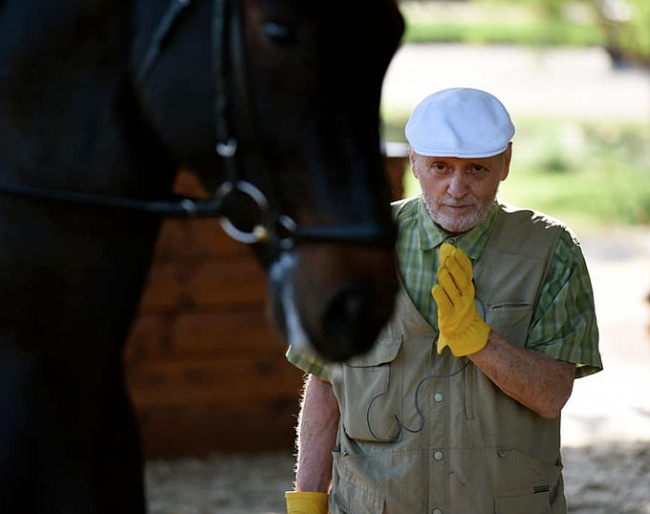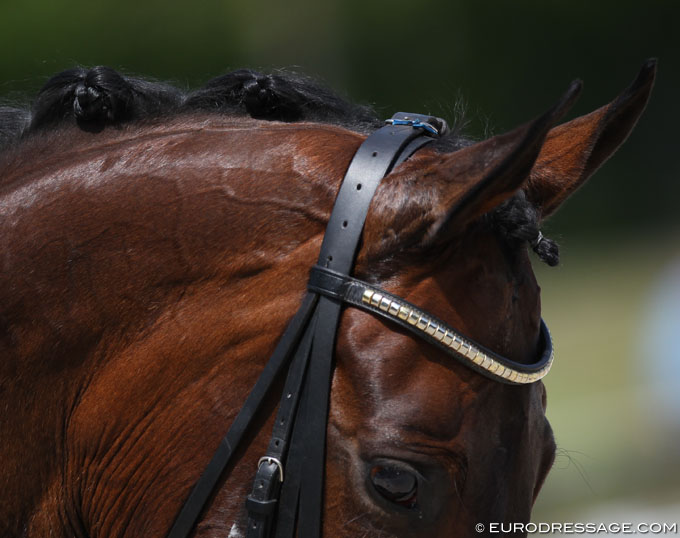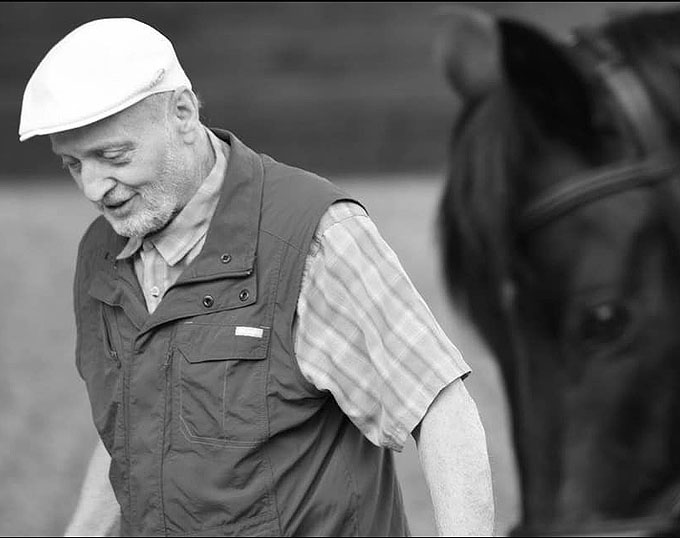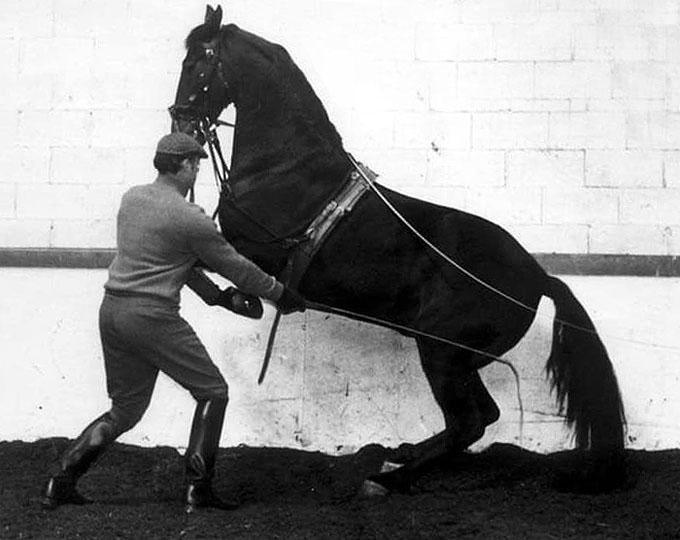
By Karl Mikolka - first printed in Dressage & CT, January 1974, reprinted in USDF Connection, May 2014
Although it is always dangerous in riding to single out individual parts of the horse for discussion, i would like to mention a few things about the neck of the horse. This is a part of the body that demands special attention from the trainer. The basic gaits and the neck of the horse determine the correctness of every task set before the horse.
Very seldom does one find a horse with an ideal neck, and in many cases the rider must “re-form” the neck in order to make it suitable for riding purposes. This re-forming of the neck is simple in some cases, extremely difficult in others. it is easy with a horse of generally good conformation including a long neck and small jaw bone. it is difficult with a horse with a short, low set-on neck with a wider jaw, and most difficult when in addition to these problems, the horse has deficient conformation and motion. With knowledge, patience, and time, however, every neck can be worked according to the body of the horse and brought into a form which guarantees the preservation of the horse’s legs and obedience to the rider’s aids.
The neck consists of seven vertebrae, each of which is flexible upward and downward. There is considerable lateral flexibility between the neck and the withers, much less, however, between the second and third vertebrae of the neck near the poll. (Count from the poll down towards the withers, one through seven.)
The two most common abnormalities in neck structure, the ewe-neck and the over-bent neck, present the problem of the rider’s rein aids meeting the neck vertebrae at a wrong angle. The aids are consequently lost above or below the de- sired point, without going through the entire horse as they should. With a neck of normal vertebral structure, the rein aids work against the neck in a straight line to the back and hind legs of the horse. The prerequisite for this is that the rider’s hands stay on their side of the withers with the neck muscles relaxed.
The work with the horse’s neck can be divided into the following stages: 1) the correct build-up of the vertebrae, and 2) the corresponding development of muscles, tendons, and ligaments. A well-worked, supple neck builds up in a straight line in front of the rider. it is wide at the withers and the crest pointed at the poll—at its highest point. At many of my clinics, however, i have seen and ridden horses with necks in the opposite proportions: narrow in front of the withers and wider at the poll.
In the first phase of working the neck, as in the first phase of riding young horses, it is necessary to awaken the trust of the horse to his trainer. only when this trust is assured can the trainer begin the work which will transform the horse’s neck. The following are the various stages in the work of the horse’s neck.
I. The search for the rider’s hand to the point at which the horse drops his poll (contact).
II. The submission to the single inward bending rein aids, so that the horse finds the outside rein (bending).
III. The transformation of the neck through the activity of the outside rein in connection with the inner rein (collection).
I. The Search for the Rider’s Hands—Dropping of the Poll

If the horse has stretched its neck as far as it can at an even, rhythmic trot, then it will let its nose fall. now the horse has found his balance and is not tensing any muscles. This is the moment the horse must find contact with the rider’s hand. The rider then must pay attention to the gait of his horse that it becomes active and that the horse begins to really push with his hind legs, not just drag them along. Through the increased activity in the hind legs, the horse’s weight becomes heavier on the bit. The rider must accept this weight with passive hands and long reins, whereby the resistance in the jaw muscles is overcome and the horse’s poll is “caught” (brought into the proper position).
At this stage in the horse’s training, all transitions to slower gaits and to the halt happen by allowing the horse to slow down gradually. The rider no longer accompanies the forward movement of his horse (as he did while encouraging the horse to continue in that gait). The forward thrust of the horse is stopped by the rider’s still but not backward-pulling hand.
II. Submission to the Rein of One Side
Once the rider has succeeded in “catching” the poll of his horse, as previously described, the foundation of the rider’s superiority over his horse is established. in the initial stages of training, this work must be repeatedly confirmed. only then can the rider begin to work with the rein of one side.
in order not to lose the horse’s trust in the just recently established rein contact, we awaken the horse’s understanding for one rein by the inactivity of the other rein. Simple turns in forward motion are the most suitable for explanation of the use of the inner rein. The old masters stressed again and again that the first and most important lesson a horse must learn is the correctly executed turn. At first the rider asks his horse to make turns on a large arc, allowing the outside rein to become longer so that only the inner rein has contact and his horse becomes alert to the rein’s effect. The rider’s weight stays in the direction of the turn, and the outside rein should take up contact again after the turn. This way of bringing the horse onto the inside aids throws the haunches slightly and the main weight of the horse comes onto his outside shoulder. The rider should accept this, as this stage in training doesn’t last long enough to damage the shoulder in any way.
On the other hand, if the rider were to try to keep the horse’s weight of the outside shoulder from the very beginning by the use of rein and leg, the horse would not understand these aids. in order to make himself understood, the rider would have to use a substantial amount of strength. every such show of strength causes the horse a certain amount of discomfort, and the horse will show resistance to the discomfort. Therefore, we wouldn’t be suppling, organizing, and developing the muscles, but rather cramping and hardening them.

corners while competing in a Grand Prix test
After achieving submission to the inside rein in motion, it is advantageous to the rider and educational for the horse to practice this submission at the halt. The rider halts his horse on the track and, by releasing one rein and using the other, encourages his horse to look in that direction. The old masters felt it of extreme importance to see that the horse neither leaned nor actually stepped to the side during this exercise, and therefore demanded that this important exercise be done with caution. if the rein aids are given too quickly and too harshly, the horse will resist by leaning to the side in the opposite direction and avoid the bending. in even worse cases the horse will step to the side and thereby learn an effective way of avoiding the bending in balance.
In summation we could say that the horse should stand still on his four feet during bending exercises. He should neither step forward, sideways, or backward, and the rider must use very tactful aids in order not to throw his horse out of balance.
III. Transforming the Neck by the Use of the Outside Rein
It is the task of the trainer to organize and develop the suppled neck muscles once these are prepared and the horse willingly comes on to the outside aids. The first use of the outside rein is to limit the bending produced by the inner rein. Beyond this limitation the bending can go no further. Thus the outside rein lines the hindquarters up with the forehand, which increases the impulsion and improves the stride. in order to thrust, there must be a certain amount of bending in the haunches present to encourage the horse to step under and support his weight, thereby relieving the forehand of a portion of the weight.
in this way the first degree of elevation is reached. The rider will feel this through the lighter contact on the hand, and see it in the greater height of the neck and of the first few vertebrae of the neck just above the withers. This form of elevation, relatively so called, is the only effective kind for the “campagne” horse.
The other type of elevation, the absolute, is necessary in unique situations with horses whose necks are incorrectly bent and formed and where the rider must work a specific part of the neck. Without elevating the neck by the use of the rein, the rider is prevented by the horse from successfully affecting the neck. in this case the elevation itself is not the goal but rather a means to an end, and is given up immediately when the rider achieves his goal—i.e., improving the straightness and formation of the neck. Which rein is the elevation rein in this case de- pends entirely on the circumstances.
Turns in forward motion are no longer ridden by giving with the outside rein the moment the horse recognizes the outside rein as a boundary or limit for the bending. We encourage the horse to make the turn by elastic use of the inner rein with a passive outside rein and slight change in weight in the rider’s seat into the direction of the turn. After the turn, the inner rein gives as much as it took in the turn. This work on the neck continues until in the space between the neck and shoulder, close to the shoulder a wide string of muscles has been developed as visible proof of the correctness of the work. These muscles increase in strength and mass and form the solid base of the neck.
The circle is a very good means in the further training of the horse to confirm the previously mentioned work, and it is conveniently familiar to the horse from the lunge. The line of the circle aids the rider in bringing the horse on the outside rein by circle-widening aids of the rider’s inside leg.
The moment soon comes when by bringing the neck onto the outside rein, the outside rein takes over the guiding of the horse. Thus the horse chews on the outside rein, and at the same time he is completely soft on the inside rein. The hollow a green horse has in front of his shoulder up to the middle of his neck fills out with muscles so that the outside rein appears buried in the neck. Unfortunately, this muscle development—the positive result of correct fundamental work—is missing in all too many horses.
Now the transitions to the walk and halt are no longer allowed to be gradual losses of impulsion—running down—but rather are achieved through a taking up of the weight by the hindquarters and a light, elastic use of the rein. The outside rein is predominant in effect, while the inside rein checks for softness of the mouth.

If, however, the horse becomes accustomed to going against the rider’s hand at the halt, the rider will always have to get a hold of the hindquarters—if necessary by making half steps forward after the halt—and drive the horse against the unyielding hand. The unyielding hand is completely immobile. it cannot be pulled forward nor pulled back. As soon as the horse drops his nose, even slightly at the halt, the hand should accompany this motion forward. When the resistance is overcome, the hand rewards by giving.
Some horses try to free themselves of the effect of the rider’s seat at the halt by stretching downward with their head and neck, thereby pulling the rider somewhat out of the saddle. Such horses should trot until they are tired and offer to halt almost by themselves. Then the rider only needs to accept the offer.
The collecting neck work at the halt may only begin when the result of the neck work in forward motion merely needs to be maintained. At the halt, the horse can evade the effect of the rider’s weight very easily. The average rider learns to pull back and forth on the horse’s mouth, thereby neglecting the correct use of the seat. But the horse steps back and forth and tries to evade this pulling with his jaw, neck, back, and legs. Then the unfinished rider forces the head and neck of the horse into a form with total disregard for the rest of the animal’s body. The so called “false poll” comes from use of this method. This type of neck has been worked from front to rear, rather than the other way around, the correct way!
Riding on curved lines (i.e., circle, turn, half school, voltes, half voltes, serpentines, down the center) is an especially good way to perfect the neck work. This work progresses in the same degree as submission to the seat aids. We must, however, pay strict attention that these exercises are developed from the horse’s hindquarters, that both of the horse’s ears stay level, and that each rein stays and works on its own side of the neck.
It is definitely the most serious mistake in the work with the horse’s neck when a rider is misled into using his hand on the wrong side of the withers in an attempt to get the horse’s head and neck into a certain position. The effect of the use of the rein in this way is no longer directed to the hind leg on the same side. each hand in combination with the rider’s leg on the same side is responsible for the horse’s neck and shoulder of the same side. The hand can do this, however, only when it is located on a straight line between the horse’s mouth and the rider’s hip.
The horse’s alertness to the rider’s seat and leg aids will later be increased by the following exercises. in shoulder-in, the rider asks his horse intermittently to step on a straight line toward the inside of the riding hall. Follow the exercise on curved lines with middle [editor’s note: medium] trot on a straight line, especially when the horse has crept behind the bit during the more collected exercises. When a horse succeeds in creeping behind the bit, it is, in addition to being a sign of the rider’s weak seat and pulling rein work, usually a result of the lack of superiority in influence of the outside rein, i.e., the outside rein is not yet sufficiently the principal rein.

Even in the highest collection should the neck become LONG
from the withers to the poll. This line must stretch ending up
at the poll as the highest point
I would like to mention briefly here that in riding on a perfectly straight line with a young horse, there is no outside rein with preference. Both reins should have equal contact. only in turns and exercises on curved lines (at this stage of training) is the outside rein of such importance. Every lesson during the horse’s training should begin with a loosening trot. in this way the horse is driven onto both reins through the even tact [editor’s note: rhythm and tempo] of the trot. For this again is the basic criterion of the correct work of the neck: according to the stage of training, the horse goes on a straight line with steady, even contact on both reins. This confirms first the obedience to the rein aids on one side and thereby total rein obedience.
When the following two goals are reached, the neck has been basically well worked. First, the horse accepts both reins during forward motion on a straight line, and second, he accepts the outside rein while softly submitting to the inside rein in turns and other exercises on curved lines. The rider can only improve this work by making his horse even more sensitive and by refining the aids. The rider should never forget the old rule: it is not what you ride, but how you ride that determines damage or benefit to your horse’s training.
- by Karl Mikolka
Related Links
Karl Mikolka Passed Away
First Belgian Meeting In Quest of Equitation in the French Tradition
The Double Bridle: An Instrument of Understanding
Christian Carde Clinic in Finland: "Good Riding is Good Riding"
FN Training Seminar with Hess and Graf: "Quality Equitation Leads to Success"
Classical Training: Loose Rein Bending and Hyperflexion
Classical Training: It's All About the Stretch